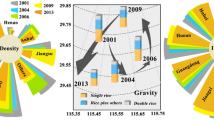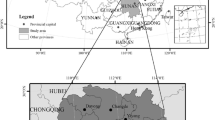Abstract
Jianghan Plain is a traditional paddy rice cropping area in southern China, consisting of single-cropping rice (SCR) and double-cropping rice (DCR). In recent years, the integrated farming of rice and crayfish (IRC) has developed rapidly in the area. The purpose of this study was to employ multiple vegetation indices derived from Moderate Resolution Imaging Spectroradiometer (MODIS) time-series data to update the rice cropping pattern map of the Jianghan Plain. The Enhanced Vegetation Index combined with Normalized Difference Vegetation Index and Land Surface Water Index was applied to extract the phenological stages of paddy fields based on their spectral signatures. Then, the spatial distribution of SCR, DCR, and IRC was mapped by the phenology-based algorithm. The spatial comparison between MODIS-based mapping results and high spatial-resolution data showed that the overall classification accuracy (CA) was 91.69%. The CA of SCR, DCR, and IRC was 91.25%, 92.00%, and 92.50%, respectively. The total MODIS-derived rice area had a good quantitative consistency with statistical data (R2 = 0.86, P < 0.01) and land-use data (R2 = 0.63, P < 0.01). The research demonstrated the promise of the MODIS dataset in mapping croplands mixed with paddy fields and rice-crayfish fields over large areas.











Similar content being viewed by others
References
Arjasakusuma S, Kusuma SS, Rafif R, Saringatin S, Wicaksono P (2020) Combination of Landsat 8 OLI and Sentinel-1 SAR time-series data for mapping paddy fields in parts of west and central Java Provinces, Indonesia. ISPRS Int J Geo-Inf 9:663. https://doi.org/10.3390/ijgi9110663
Bridhikitti A, Overcamp TJ (2012) Estimation of Southeast Asian rice paddy areas with different ecosystems from moderate-resolution satellite imagery. Agric Ecosyst Environ 146:113–120. https://doi.org/10.1016/j.agee.2011.10.016
Cao CG, Jiang Y, Wang JP, Yuan PL, Chen SW (2017) “Dual character” of rice-crayfish culture and strategy for its sustainable development. Chin J Eco-Agric 25(9):1245–1253. https://doi.org/10.13930/j.cnki.cjea.170739. (in Chinese)
Chakhar A, Hernandez-Lopez D, Ballesteros R, Moreno MA (2021) Improving the accuracy of multiple algorithms for crop classification by integrating sentinel-1 observations with sentinel-2 data. Remote Sens 13:243. https://doi.org/10.3390/rs13020243
Chen J, Jönsson P, Tamura M, Gu Z, Matsushita B, Eklundh L (2004) A simple method for reconstructing a high-quality NDVI time-series data set based on the Savitzky–Golay filter. Remote Sens Environ 91:332–344. https://doi.org/10.1016/j.rse.2004.03.014
Clauss K, Yan H, Kuenzer C (2016) Mapping paddy rice in China in 2002, 2005, 2010 and 2014 with MODIS time series. Remote Sens 8:434. https://doi.org/10.3390/rs8050434
Dong J, Xiao X, Kou W, Qin Y, Zhang G, Li L, Jin C, Zhou Y, Wang J, Biradar C, Liu J, Moore B (2015) Tracking the dynamics of paddy rice planting area in 1986–2010 through time series Landsat images and phenology-based algorithms. Remote Sens Environ 160:99–113. https://doi.org/10.1016/j.rse.2015.01.004
Elert E (2014) Rice by the numbers: a good grain. Nature 514:S50–S51. https://doi.org/10.1038/514S50a
HRSY (2021) Hubei rural statistical yearbook (2021). China Statistics Press, Beijing
Huang D (2019) Remote sensing estimation of gross primary production of paddy rice in Jianghan plain. University of Chinese Academy of Sciences, Beijing (in Chinese)
Huang HB, Cao YJ, Yin SH, Li JJ, Chen YM, Tang JQ, Liu YZ (2021) Experiment on breeding and separation of crayfish in paddy field. J Aquacult 42(04):46–49 (in Chinese)
Hubei Provincial People’s Government (2021) Hubei Province's "14th Five-Year Plan" to promote agricultural and rural modernization. Hubei Provincial People’s Government (in Chinese). http://www.hubei.gov.cn/zfwj/ezf/202111/t20211104_3845099.shtml
Huete A, Didan K, Miura T, Rodriguez EP, Gao X, Ferreira LG (2002) Overview of the radiometric and biophysical performance of the MODIS vegetation indices. Remote Sens Environ 83:195–213. https://doi.org/10.1016/S0034-4257(02)00096-2
Ji Y, Liu G, Ma J, Zhang G-B, Xu H (2014) Effects of urea and controlled release urea fertilizers on methane emission from paddy fields: a multi-year field study. Pedosphere 24:662–673. https://doi.org/10.1016/S1002-0160(14)60052-7
Jiang R, Sanchez-Azofeifa A, Laakso K, Xu Y, Zhou Z, Luo X, Huang J, Chen X, Zang Y (2021) Cloud cover throughout all the paddy rice fields in Guangdong, China: impacts on Sentinel 2 MSI and Landsat 8 OLI optical observations. Remote Sens 13:2961
Jiang Y, Lu Z, Li S, Lei Y, Chu Q, Yin X, Chen F (2020) Large-scale and high-resolution crop mapping in china using Sentinel-2 satellite imagery. Agriculture 10:433
Kuang WH, Zhang SW, Du GM, Yan CZ, Wu SX, Li RD, Lu DS, Pan T, Ning J, Guo CQ, Dong JW, Bao YH, Chi WF, Dou YY, Hou YL, Yin ZR, Chang LP, Yang JC, Xie JL, Qiu J, Zhang HS, Zhang YB, Yang SQ, Sa RG, Liu JY (2022) Remotely sensed mapping and analysis of spatio-temporal patterns of land use change across China in 2015–2020. Acta Geogr Sin 5(77):1056–1071 (in Chinese)
Li BL, Ti CP, Yan XY (2020) Estimating rice paddy areas in China using multi-temporal cloud-free normalized difference vegetation index (NDVI) imagery based on change detection. Pedosphere 30:734–746. https://doi.org/10.1016/s1002-0160(17)60405-3
Li RY, Xu MQ, Chen ZY, Gao BB, Cai J, Shen FX, He XL, Zhuang Y, Chen DL (2021) Phenology-based classification of crop species and rotation types using fused MODIS and Landsat data: the comparison of a random-forest-based model and a decision-rule-based model. Soil Tillage Res. https://doi.org/10.1016/j.still.2020.104838
Liu S, Chen Y, Ma Y, Kong X, Zhang X, Zhang D (2020) Mapping ratoon rice planting area in central china using sentinel-2 time stacks and the phenology-based algorithm. Remote Sens 12:3400
Lv T, Liu C (2010) Study on extraction of crop information using time-series MODIS data in the Chao Phraya Basin of Thailand. Adv Space Res 45:775–784. https://doi.org/10.1016/j.asr.2009.11.013
Mansaray LR, Huang W, Zhang D, Huang J, Li J (2017) Mapping rice fields in urban Shanghai, Southeast China, using Sentinel-1A and Landsat 8 datasets. Remote Sens 9:257
Minh HVT, Avtar R, Mohan G, Misra P, Kurasaki M (2019) Monitoring and mapping of rice cropping pattern in flooding area in the vietnamese mekong delta using Sentinel-1A data: a case of an Giang Province. ISPRS Int J Geo-Inf 8:211
Peng D, Huete AR, Huang J, Wang F, Sun H (2011) Detection and estimation of mixed paddy rice cropping patterns with MODIS data. Int J Appl Earth Obs Geoinf 13:13–23. https://doi.org/10.1016/j.jag.2010.06.001
Qiu J, Li R, Zhu H, Xia J, Xiao Y, Huang D, Wang Y (2020) The effect of ecological environmental changes and mollusciciding on snail intermediate host of Schistosoma in Qianjiang city of China from 1985 to 2015. Parasites Vectors. https://doi.org/10.1186/s13071-020-04273-1
Su R, Xiong Q, Gong Y, Liu K, Gao H, Jin W (2013) Cotton and mid-season rice area extraction based on multi-temporal HJ satellite CCD data in Southern Jianghan Plain. Resour Environ Yangtze Basin 22:1441–1448 (in Chinese)
Tian H, Wu M, Wang L, Niu Z (2018) Mapping early, middle and late rice extent using Sentinel-1A and Landsat-8 data in the Poyang Lake Plain, China. Sensors 18:185
Wang RJ, Li XB, Tan MH, Xin LJ, Wang X, Wang YH, Jiang M (2019) Inter-provincial differences in rice multi-cropping changes in main double-cropping rice area in China: evidence from provinces and households. China Geogr Sci 29:127–138. https://doi.org/10.1007/s11769-018-0972-4
Wang S, Wang Y, Wu Z, Wang S, Hu Q, Gao Y, Mu Q, Tian X (2021) Adaptability screening of high-quality rice varieties in Jianghan Plain. China Rice 27:98–103+108. https://doi.org/10.3969/j.issn.1006-8082.2021.01.019
Wang Y, Zhao F, Wu Z, Wang S, Hu Q, Qiu X, Tian X (2020) Adaptability evaluation of rice varieties from South China District in Jianghan Plain. China Rice 26:57–62. https://doi.org/10.3969/j.issn.1006-8082.2020.01.013
Wei Y, Lu M, Yu Q, Xie A, Hu Q, Wu W (2021) Understanding the dynamics of integrated rice–crawfish farming in Qianjiang county, China using Landsat time series images. Agric Syst 191:103167. https://doi.org/10.1016/j.agsy.2021.103167
Xia T, Ji W, Li W, Zhang C, Wu W (2021) Phenology-based decision tree classification of rice-crayfish fields from Sentinel-2 imagery in Qianjiang, China. Int J Remote Sens 42:8124–8144. https://doi.org/10.1080/01431161.2021.1973687
Xiao XM, Boles S, Frolking S, Li C, Babu JY, Salas W, Moore B (2006) Mapping paddy rice agriculture in South and Southeast Asia using multi-temporal MODIS images. Remote Sens Environ 100:95–113. https://doi.org/10.1016/j.rse.2005.10.004
Xiao XM, Boles S, Frolking S, Salas W, Moore B, Li C, Longhua H, Zhao R (2002) Observation of flooding and rice transplanting of paddy rice fields at the site to landscape scales in China using VEGETATION sensor data. Int J Remote Sens 23:3009–3022. https://doi.org/10.1080/01431160110107734
Xiao XM, Boles S, Liu J, Zhuang D, Frolking S, Li C, Salas W, Moore B (2005) Mapping paddy rice agriculture in southern China using multi-temporal MODIS images. Remote Sens Environ 95:480–492. https://doi.org/10.1016/j.rse.2004.12.009
Xin LJ, Li XB (2009) Changes of multiple cropping in double cropping rice area of southern China and its policy implications. J Nat Resour 24(1):58–65 (in Chinese)
Yang WJ, Wang Y (2013) Analysis of multiple cropping changes and influencing factors in double-cropping rice areas in China: an empirical study based on 10 major rice-producing provinces. Rural Econ 11:24–28 (in Chinese)
Yuan PL, Wang JP, Guo C, Guo ZY, Guo Y, Cao CG (2022) Sustainability of the rice-crayfish farming model in waterlogged land: a case study in Qianjiang County, Hubei Province, China. J Integr Agric 21:1203–1214. https://doi.org/10.1016/s2095-3119(21)63787-5
Zhang G, Xiao X, Biradar CM, Dong J, Qin Y, Menarguez MA, Zhou Y, Zhang Y, Jin C, Wang J, Doughty RB, Ding M, Moore B (2017) Spatiotemporal patterns of paddy rice croplands in China and India from 2000 to 2015. Sci Total Environ 579:82–92. https://doi.org/10.1016/j.scitotenv.2016.10.223
Zhang G, Xiao X, Dong J, Kou W, Jin C, Qin Y, Zhou Y, Wang J, Menarguez MA, Biradar C (2015) Mapping paddy rice planting areas through time series analysis of MODIS land surface temperature and vegetation index data. ISPRS J Photogramm Remote Sens 106:157–171. https://doi.org/10.1016/j.isprsjprs.2015.05.011
Zhang M, Chen HG, Huang CG, Wang MB, Gai JJ, Li Q, Hu X (2020) Efficient breeding and separation technology for rice-crayfish. Mod Agric Sci Technol 24:191–193 (in Chinese)
Zhangtiansi Township’s Government (2019) Work summary in 2019 and work ideas in 2020 in Zhangtiansi Township, Gong’an County. http://www.gongan.gov.cn/xxgk/dfbmptlj/xzzfxxgg/ztsxpt/202010/t20201029_535101.shtml. Accessed on 15 Aug 2022
Zhao JL, Dong YY, Zhang MM, Huang LS (2020) Comparison of identifying land cover tempo-spatial changes using GlobCover and MCD12Q1 global land cover products. Arab J Geosci. https://doi.org/10.1007/s12517-020-05780-2
Zhou L, Zhou Y (2011) Food security: climate change and industrial transfer. China Popul Resour Environ 21:162–168
Zhou Y, Yan XY, Gong SL, Li CW, Zhu R, Zhu B, Liu ZY, Wang XL, Cao P (2022) Changes in paddy cropping system enhanced economic profit and ecological sustainability in central China. J Integr Agric 21:566–577. https://doi.org/10.1016/s2095-3119(21)63841-8
Zhu L, Liu X, Wu L, Liu M, Lin Y, Meng Y, Ye L, Zhang Q, Li Y (2021) Detection of paddy rice cropping systems in southern China with time series Landsat images and phenology-based algorithms. Gisci Remote Sens 58:733–755. https://doi.org/10.1080/15481603.2021.1943214
Acknowledgements
We thank the editors of the Paddy and Water Environment, the anonymous reviewers for their valuable suggestions, and the data providers (USGS) that supplied the remote sensing data in AρρEEARS.
Funding
This research was supported by a Grant from the State Key Laboratory of Resources and Environmental Information System [Grant No. 202026] and the National Natural Science Foundation of China under Grant [Grant No. 62071457].
Author information
Authors and Affiliations
Contributions
Conceptualization, QS, RL, and HC; methodology, QS, RL, and HC; validation, QS and HC; formal analysis, QS and HC; investigation, QS, JQ, YH, DH, and MC; data curation, QS, JQ, and DH; writing-original draft preparation, QS and HC; writing-review and editing, QS, HC, and YH; supervision, QS and HC; project administration, QS and HC. All authors have read and agreed to the published version of the manuscript.
Corresponding author
Ethics declarations
Conflict of interest
The authors declare that they have no conflict of interest.
Supplementary Information
Below is the link to the electronic supplementary material.
Rights and permissions
Springer Nature or its licensor (e.g. a society or other partner) holds exclusive rights to this article under a publishing agreement with the author(s) or other rightsholder(s); author self-archiving of the accepted manuscript version of this article is solely governed by the terms of such publishing agreement and applicable law.
About this article
Cite this article
Shao, Q., Li, R., Qiu, J. et al. Large-scale mapping of new mixed rice cropping patterns in southern China with phenology-based algorithm and MODIS dataset. Paddy Water Environ 21, 243–261 (2023). https://doi.org/10.1007/s10333-023-00926-w
Received:
Revised:
Accepted:
Published:
Issue Date:
DOI: https://doi.org/10.1007/s10333-023-00926-w




